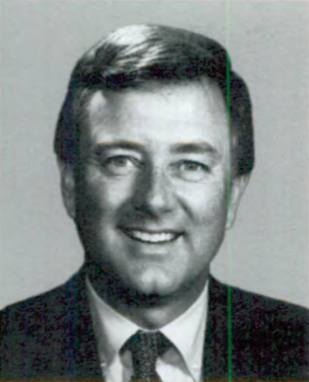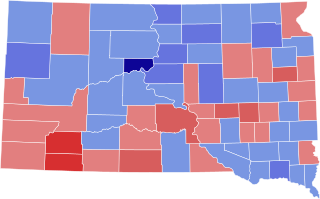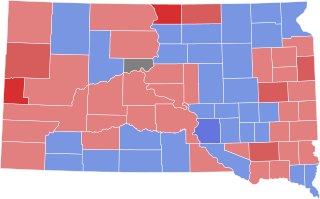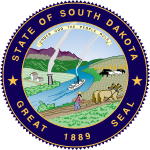
William Henry McMaster was an American politician who served as the tenth Governor of South Dakota from 1921 until 1925. A member of the Republican Party, he went on to serve as a member of the United States Senate from South Dakota from 1925 to 1931.

The 1948 United States Senate election in South Dakota took place on November 2, 1948. Incumbent Republican Senator Harlan J. Bushfield, suffering from poor health, declined to run for re-election. On September 27, 1948, he died in office; his wife, Vera C. Bushfield, was appointed to succeed him. Congressman Karl E. Mundt easily won the Republican primary and advanced to the general election, where he was opposed by Democratic nominee John A. Engel, an attorney. Hundt defeated Engel in a landslide.

The 1932 United States Senate election in South Dakota took place on November 8, 1932. Incumbent Republican Senator Peter Norbeck ran for re-election to a third term. After easily turning back a challenge from former State Senator Harry F. Brownell in the Republican primary, Norbeck faced attorney Ulysses Simpson Grant Cherry, the Democratic nominee, in the general election. Owing in part to Franklin D. Roosevelt's landslide victory in South Dakota, the race was much closer than it was in 1926, but Norbeck still defeated Cherry by a decisive margin to win his third, and final, term. Norbeck died in office on December 20, 1936, triggering a special election in 1938.

The 2014 United States Senate election in South Dakota took place on November 4, 2014, to elect a member of the United States Senate to represent the state of South Dakota, concurrently with the election of the Governor of South Dakota, as well as other elections to the United States Senate in other states and elections to the United States House of Representatives and various state and local elections.

The 1950 United States Senate election in South Dakota took place on November 7, 1950. Incumbent Republican senator Chan Gurney ran for re-election to a third term. He was challenged in the Republican primary by Congressman Francis H. Case, who had represented the 2nd District since 1939. In the general election, Case faced John A. Engel, an attorney and the 1948 Democratic nominee for the U.S. Senate. As the Republican Party was making significant gains nationwide, Case defeated Engel in a landslide.

The 1918 United States Senate election in South Dakota took place on November 5, 1918. Incumbent Republican Senator Thomas Sterling sought re-election in his first popular election. He defeated former Governor Frank M. Byrne in the Republican primary and then faced former State Representative Orville Rinehart, the 1916 Democratic nominee for Governor, in the general election. Sterling defeated Rinehart, along with independent candidate W. T. Rafferty, by a wide margin to win re-election.

The 1930 United States Senate election in South Dakota took place on November 4, 1930. Incumbent Republican Senator William H. McMaster ran for re-election to a second term. After beating back a challenge in the Republican primary from former State Senator George J. Danforth, McMaster faced Democratic nominee William J. Bulow, the incumbent Governor, in the general election. As the Democratic Party performed well nationwide, Bulow narrowly defeated McMaster.

The 1936 United States Senate election in South Dakota took place on November 3, 1936. Incumbent Democratic Senator William J. Bulow ran for re-election to a second term. He was challenged by businessman Chan Gurney, who defeated former Congressman Charles A. Christopherson in the Republican primary. Bulow, likely aided by President Franklin D. Roosevelt's landslide victory in South Dakota, narrowly defeated Gurney to win his second term, though he significantly underperformed Roosevelt.

The 1932 United States Senate election in South Dakota took place on November 7, 1944. Incumbent Republican Senator Chan Gurney ran for re-election to a second term. He faced a strong challenge in the Republican primary from Lieutenant Governor A. C. Miller, who claimed that Gurney was too friendly to New Deal policies, but was defeated by Gurney by a wide margin. In the general election, Gurney faced former State Senator George M. Bradshaw, whom he defeated in a landslide as Thomas E. Dewey was decisively winning the state over President Franklin D. Roosevelt in the presidential election.

The 1954 United States Senate election in South Dakota took place on November 2, 1954. Incumbent Republican Senator Karl E. Mundt ran for re-election to his second term. He was opposed by former State Representative Kenneth Holum, the Democratic nominee. Mundt defeated Holum in a landslide to win re-election.

The 1962 United States Senate election in South Dakota took place on November 6, 1962. Incumbent Republican Senator Francis H. Case ran for re-election to a third term. He won the Republican primary against Attorney General A. C. Miller, but shortly after the primary, died. The Republican State Central Committee named Lieutenant Governor Joseph H. Bottum as Case's replacement on the ballot, and Governor Archie Gubbrud appointed Bottum to fill the vacancy caused by Case's death. In the general election, Bottum was opposed by Democratic nominee George McGovern, the Director of Food for Peace and the former U.S. Congressman from South Dakota's 1st congressional district. The contest between Bottum and McGovern was quite close, with McGovern narrowly defeating him for election by just 597 votes, making him the first Democrat to win a Senate election in South Dakota since William J. Bulow's win in 1936.

The 1966 United States Senate election in South Dakota took place on November 8, 1966. Incumbent Republican Senator Karl E. Mundt ran for re-election to his fourth term. He was challenged in the Republican primary by a John Birch Society member, but easily turned away the challenge. In the general election, he faced State Representative Donn Wright, the Democratic nominee. Owing in large part to the Republican landslide taking place nationwide, Mundt defeated Wright by an unprecedented margin.

The 1968 United States Senate election in South Dakota took place on November 5, 1968. Incumbent Democratic Senator George McGovern ran for re-election to a second term. He was challenged by former Governor Archie M. Gubbrud, who was persuaded to enter the race by the South Dakota Republican establishment. McGovern defeated Gubbrud by a wide margin, even as Richard Nixon was defeating Hubert Humphrey in the state's presidential election in a landslide.

The 1972 United States Senate election in South Dakota took place on November 7, 1972, concurrently with the U.S. presidential election as well as other elections to the United States Senate in other states as well as elections to the United States House of Representatives and various state and local elections.

The 1912 South Dakota gubernatorial election was held on November 5, 1912. Incumbent Republican Governor Robert S. Vessey declined to run for re-election to a third term. Lieutenant Governor Frank M. Byrne won the Republican primary to succeed Vessey, and then faced State Senator Edwin S. Johnson, the Democratic nominee, in the general election. Byrne only narrowly defeated Johnson, winning just 49% of the vote to Johnson's 46%, the closest gubernatorial election since 1898.

The 1938 United States Senate elections in South Dakota took place on November 8, 1938. Incumbent Republican Senator Peter Norbeck died in office on December 20, 1936. Herbert E. Hitchcock was appointed by Governor Tom Berry as Norbeck's replacement. Two elections for the same Senate seat were held on the same day; one as a special election to fill the remainder of Norbeck's six-year term, and another to select a Senator to serve the next six-year term.

The 1920 South Dakota gubernatorial election was held on November 2, 1920. Incumbent Republican Governor Peter Norbeck declined to run for re-election, instead choosing to run for the U.S. Senate. Lieutenant Governor William H. McMaster won the Republican primary and advanced to the general election, where he faced Nonpartisan League candidate Mark P. Bates and former State Senator William W. Howes, the Democratic nominee. The election was largely a replay of the 1918 election, with McMaster winning a large victory, Bates coming in second, and Howes coming in a distant third.

The 1924 South Dakota gubernatorial election was held on November 4, 1924. Incumbent Republican Governor William H. McMaster declined to run for re-election to a third term, instead opting to run for the U.S. Senate. Lieutenant Governor Carl Gunderson won the Republican primary unopposed. In the general election, he faced three prominent opponents: Democratic nominee William J. Bulow, a former State Senator and Mayor of Beresford; Farmer–Labor nominee A. L. Putnam; and perennial candidate Richard O. Richards. Gunderson. With the left-leaning vote split, Gunderson won the election in a landslide.

The 1938 South Dakota gubernatorial election was held on November 8, 1938. Incumbent Republican Governor Leslie Jensen declined to seek re-election and instead unsuccessfully ran for the U.S. Senate. Harlan J. Bushfield, the former Chairman of the South Dakota Republican Party, won the Republican primary to succeed Jensen. In the general election, he faced Democratic nominee Oscar Fosheim, a State Representative from Miner County, in the general election. Bushfield defeated Fosheim by a relatively close margin, winning his first term as governor.

The 1940 South Dakota gubernatorial election was held on November 5, 1940. Incumbent Republican Governor Harlan J. Bushfield sought re-election to a second term. After winning the Republican primary by a large margin, he faced Democrat Lewis W. Bicknell, former Day County State's Attorney, in the general election. Though Bushfield underperformed Republican presidential nominee Wendell Willkie, who won the state in a landslide, he nonetheless defeated Bicknell by a wide margin to easily win re-election.






















